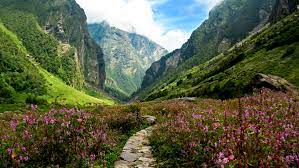Introduction
Nature’s beauty can be found anywhere in the world, but some locations have a really mysterious allure that mesmerizes tourists. The Valley of Flowers, a captivating oasis hidden amid the beautiful Himalayan mountains in the Indian state of Uttarakhand, is one such enticing wonder. This ethereal refuge, which is appropriately titled, is a floral symphony that exhibits nature’s artistic talent at its best and The Valley of Flowers trek is a well-known and sought-after trekking route in India. It offers a unique opportunity to explore the picturesque landscapes and abundant floral diversity of the Himalayas.
Location and Accessibility:
The Valley of Flowers is part of the Nanda Devi Biosphere Reserve, a UNESCO World Heritage Site, and is located in the Chamoli district of Uttarakhand. This breathtaking valley is located at an elevation of approximately 3,500 to 4,000 meters above sea level, making it only accessible during certain months of the year.
To reach this floral paradise, one must embark on a moderate trek that begins in the picturesque village of Govindghat. The 17-kilometer trek takes adventurers through a variety of landscapes, including gushing rivers, dense forests, and charming meadows adorned with wildflowers. The journey is both a physical and spiritual challenge, bringing travelers closer to nature’s wonders.
Floral Extravaganza:
The Valley of Flowers comes alive in the summer months, from late June to September, when the snow melts and a vibrant carpet of blossoms emerges. Because of the limited window of opportunity, the experience becomes even more valuable and exclusive.
Visitors are greeted with an explosion of colors as they enter the valley, an array of flowers in various shapes and sizes dancing in the gentle breeze. Over 300 species of wildflowers dot the landscape, with blooms including primulas, poppies, daisies, anemones, and brahma kamal, Uttarakhand’s state flower. Because of the valley’s unique climatic conditions, rare and endangered plant species have flourished, making it a botanical treasure trove.
Aside from the flowers, the valley is home to a variety of wildlife, including the elusive snow leopard, musk deer, blue sheep, and a variety of avian species. The balance of flora and fauna creates a delicate ecosystem that adds to the allure of the valley.
Photographer’s Paradise:
The Valley of Flowers is an unrivaled paradise for photographers and nature lovers. Every step provides an opportunity to photograph blooming flowers, cascading waterfalls, and panoramic mountain views. The changing light of the day creates a magical play of shadows and highlights, adding to the visual appeal of this natural masterpiece.
Preservation and Conservation:
Recognizing the Valley of Flowers’ ecological significance and fragility, the Indian government, in collaboration with environmentalists and local communities, has taken significant steps to preserve it. To protect the fragile ecosystem, strict regulations are in place, and only a limited number of tourists are permitted each year. Visitors are expected to practice responsible tourism, ensuring that no harm is done to the environment or its inhabitants.
Responsible travel also entails returning all waste and refraining from picking flowers or disturbing wildlife. We can ensure that this floral symphony continues to enchant future generations by being conscious travelers.
Spiritual and Meditative Experience:
Beyond its aesthetic beauty, the Valley of Flowers has a spiritual essence that many visitors find appealing. The tranquil atmosphere and deep connection with nature create a meditative atmosphere. It’s no surprise that locals believe this valley is the celestial playground of Hindu deities, and the mythical associations only add to the valley’s spiritual allure.
The Valley of Flowers experience is often transformative for trekkers who make it there, leaving them with a renewed appreciation for the harmony that exists in the natural world and a deep sense of gratitude for Mother Nature’s gifts.
Tips for Explorers:
Those who want to visit this floral wonderland must be well-prepared and responsible. Here are some pointers to help you make the most of your experience:
- Timings: Plan your visit between late July and September, when the valley is in full bloom.
- Physical Fitness: The trek has moderate difficulty levels, so make sure you’re physically fit for it.
- Permits: Before entering the national park, obtain the necessary permits from the Forest Department.
- Pack Caution: Bring water, snacks, rain gear, a first-aid kit, and appropriate trekking gear.
- Respect Nature: Follow the “Leave No Trace” principle to avoid disturbing the flora and fauna.
- Responsible Waste Disposal: Bring back all non-biodegradable waste and properly dispose of it.
Conclusion:
The Valley of Flower Trek is a testament to nature’s immense beauty and diversity. Its enthralling floral symphony is a harmonious dance of colors, scents, and life that will leave all who visit with memories to last a lifetime. This magnificent destination is not only a visual treat, but also a spiritual journey that fosters a profound connection with nature. Let us remember to tread gently and responsibly as we continue to explore and admire the wonders of this planet so that future generations can also enjoy the Floral Symphony of the Valley of Flowers.





